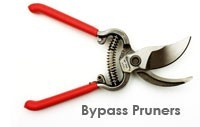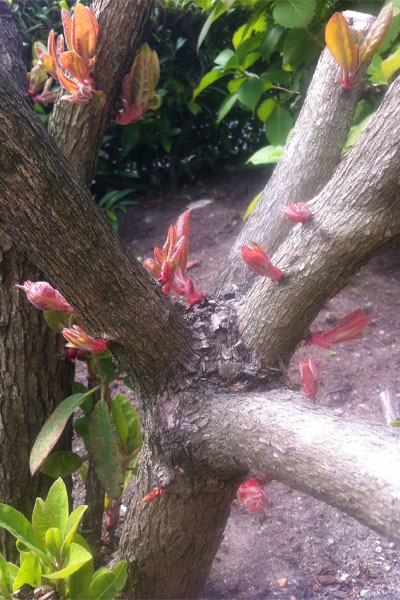Large-leaved rhododendrons, such as my favorites: the Southgate Rhododendrons, do not require pruning, however can be pruned. I usually don't prune Rhododendrons until they are 5 years old. That being said, I usually do some maintenance pruning (see below) on both young and old plants.
In general, the large-leaved rhododendrons are the most difficult to prune, but only because most folks don't know enough about their growth cycle. Too, rhododendrons just look as though pruning would destroy the natural beauty and form of the plant. And, as with most other types of plants, improper pruning can do just that.
Here's a little info on the growth cycle of a rhododendron throughout a year...
In spring, after they bloom, rhododendrons put out their first growth in a flush of leaves at the ends of the branches. On young healthy plants, two of these new growth flushes per year are typical. On older plants that set flowers freely, it is the rule that one flush is made after the bloom. This is due to the use of tremendous energy in blooming.
When to Prune
Rhododendrons can be pruned at any time during the year without harming the plant, but there are times that are better for pruning. You can snip a stray or broken branch that spoils the shape of the plant at any time of year but more extensive pruning is usually done right after flowering.
Rhododendrons flower on the prior year's wood. In other words, the buds for spring flowering form on the plants during the previous summer or fall. So, keep in mind, if you prune in the late summer, fall, or winter, you may be trimming off your flowers for the following spring.
Pruning Instructions
There are three common reasons for pruning rhododendrons: maintenance, shaping, and rejuvenation of very old plants. The pruning method for each is different. When pruned properly, the result is a fuller plant that produces an abundance of flowers.
Maintenance Pruning
Maintenance pruning is performed on rhododendrons just after they have flowered. This method of pruning consists of removing spent flower clusters, and also the removal of any dead or diseased wood from within the plant. It is the easiest of the methods to do and the only one that you do every year.

Maintenance pruning is best done after the flowers have faded and before the flush of new growth that rises beneath each spent cluster is more than an inch or so tall. The spent flower clusters are not only unsightly but will eventually form seed, which uses precious energy that would otherwise be available to the plant for foliage growth.
To remove spent flower clusters on your rhododendron, use your thumb and forefinger or a hand pruner to snip the cluster off at about 1/2 inch above the emerging flush of new growth (leaves). We suggest using a sharp pair of bypass hand pruners, such as the ones pictured, because sometimes when using your fingers to break the cluster off it removes some of the new leaves.
Shaping

Before getting into how to prune to shape rhododendrons at various stages of their life here's a little information about their growth. With few exceptions, rhododendrons retain their leaves for two years. This means on a rhododendron that is 2 years or older there will be four rosettes (clusters) of leaves along most branches, representing the last two years growth. Any older leaves will have fallen from the plant. The rosettes of foliage are separated by sections of leafless stem, called internodes. On older plants, which usually have only one flush of new growth per year, there might be only two rosettes of leaves: one rosette at the end of the branch and one further down the branch.
Okay, now to shaping. Shaping of established rhododendrons is done selectively using hand pruners (bypass pruners) and is designed to develop the most aesthetically pleasing aspects of the plant's natural habit and form. Shaping improves the appearance of a plant by encouraging increased branching at its growing points. Shaping is most easily done in late winter, while the plant is dormant. Although this sacrifices some of the flower buds, it ensures a complete growing season for the new stems that emerge. This being said, shaping can be done immediately after flowering.
To shape a rhododendron, follow the branch from the top down to the last rosette of leaves you want to keep. Make the cut about 1/4 inch above the topmost leaf in this cluster. Repeat this process throughout the shrub as needed or desired.
NOTE: Shaping should not be done on leggy or very large plants, as their open habit requires a more drastic technique called rejuvenation pruning, discussed next below.
Rejuvenation Pruning
Rejuvenation pruning is used to restore old rhododendrons that have become leggy, overgrown, or otherwise just plain ugly. Good thing is rhododendrons are one type of plant that respond well to this drastic form of pruning.
Rejuvenation pruning works on rhododendrons because they produce small buds all over the surface of branches, even the old ones. If you look closely at the bark you'll see tiny pink buds everywhere. When you cut back a main branch, from these latent buds will emerge new growth (as seen in the image below) that begins to form the new shrub.

It's best to perform rejuvenation pruning in winter when the plant is totally dormant in late winter, before any new growth begins to emerge. Even though you'll be removing most of the plants branches, and probably all of its leaves, many species of rhododendron will come back good as new after rejuvenation pruning, quickly flushing new growth that will mature into new branches that can be shaped in the future to reestablish a healthy, dense shrub that produces an abundance of flowers.

Rhododendrons usually have several main branches (trunks) that emerge from the ground. Rejuvenation pruning involves the careful cutting back of each one of these main branches. You'll want to cut each main branch at a different height so that when the plant reestablishes itself it will have a natural shape and appearance. Cut these main branches (trunks) to various heights of 18 to 30 inches above the ground and just above a leaf bud on the branch.

Another more severe type of rejuvenation pruning involves cutting the main branches (trunks) to a point 6 inches or so above the ground. This is a quick method and plants don't always survive such severe pruning. You can always test whether or not this will work by cutting back only one of the main branches to 6 inches in height to see if new growth will emerge, cutting the others back randomly to 18 to 30 inches or so in height. If new growth emerges from the trunk that you cut back to 6 inches in height you can cut back the others back the following year.

